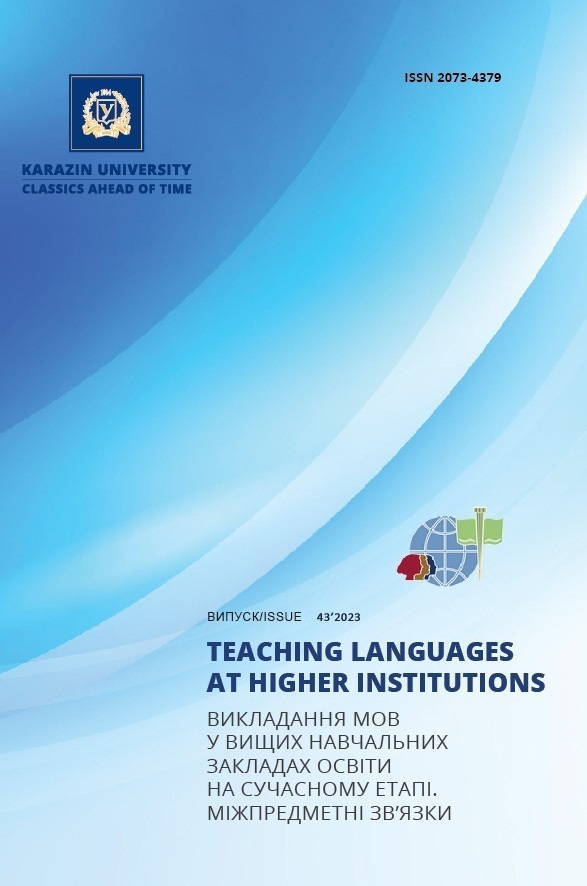The linguistic and didactic potential of a culinary recipe in teaching Ukrainian as a foreign language
Abstract
The primary challenge in teaching Ukrainian as a foreign language is to identify language units, speech genres, or text types relevant for use in the educational process to develop the communicative and linguistic-cultural competence of learners. Given the significance of gastronomic culture in the modern world, a culinary recipe can serve as a valuable source of information about national cultural traditions and material for developing communication and intercultural skills.
The article explores the concept of a ʼculinary recipeʼ and the specific characteristics that make it a distinct type of text with potential applications in teaching Ukrainian as a foreign language. It argues that the linguistic and didactic potential of a culinary recipe is grounded in its features, such as compact size, the presence or potential use of visual aids for information presentation, a typical and repeated text structure, and optimal lexical content in terms of frequency of usage and stylistic neutrality. This content includes background and non-equivalent vocabulary, borrowings, internationalisms, hyperonyms, hyponyms, words related to product names, dishware, and other kitchen utensils, gustatory and deverbative culinary adjectives, as well as culinary verbs and verbs related to food processing.
The article also emphasizes the presence of typical structural models in word combinations and sentences. Special attention is given to the appropriateness and effectiveness of studying dish names and processing productive grammatical models, particularly word combinations. It highlights the importance of avoiding categorical imperatives in language materials and suggests processing culinary instructions primarily with the verb form in the 1st person plural.
In conclusion, the author recommends the integration of culinary recipes into Ukrainian language classes for foreign language learners, particularly for students at proficiency levels approaching A2–B1.
Downloads
References
Burnos, Ye. (2021). Traditional national food in ethnographic and linguistic studies. Humanities Science Current Issues: Interuniversity collection of Drohobych Ivan Franko State Pedagogical University Young Scientists Research Papers, 38 (1), pp. 110–115. DOI: https://doi.org/10.24919/2308-4863/38-1-16 [in Ukrainian].
Dolgusheva, O.V. (2019). Didactic potential of English-language culinary recipes. III International Scientific and Practical Internet Conference “Foreign Language in Professional Training of Specialists: Issues and Strategies. Volodymyr Vinnychenko Central Ukrainian State Pedagogical University. Available at: https://bit.ly/3EtFXnd [Accessed: 07 Aug. 2023] [in Ukrainian].
Dolgusheva, O.V., Kochubej, V.Yu. (2023). Culinary recipe as a means of fostering English linguistic and speech competences. Transcarpathian Philological Studies, 27 (2), pp. 56–63. DOI: https://doi.org/10.32782/tps2663-4880/2022.27.2.11 [in Ukrainian].
Dolgusheva, O. (2019). Modification of the “cooking recipe” genre in the novel “Tuscany for Beginners” by I. Edwards-Jones. Scientific papers [of Volodymyr Vinnichenko Central Ukrainian State Pedagogical University], 175, pp. 447–457 [in Ukrainian].
Ivchenko, Zoryana. (2021). Letʼs cook the Ukrainian way. Lviv: Urbino [in Ukrainian].
Yurchuk, O.O., Grymasevich, G.I., Chaplinska, O.V. (Eds.). (2020). Yizha v kulturnomu prostori [Food in the cultural space]. Zhytomyr: Ivan Franko State University Publishing Center [in Ukrainian]
Klopotenko, Yevhen (2019). Zvablennya yizheyu [Seduction by food]. Kyiv: Knygolav [in Ukrainian].
Kovalchuk, O.S. (2016). Linguistic features of food technology discourse. Bulletin of the Chernihiv National Pedagogical University. Series “Pedagogical Sciences”, 141, pp. 83–89 [in Ukrainian].
Kochan, I., Lytvynovych, R. (2023). The dynamics of the names of kitchen utensils and tableware in the Ukrainian language. Theory and Practice of Teaching Ukrainian as a Foreign Language, 17, pp. 160–168. DOI: http://dx.doi.org/10.30970/ufl.2023.17.3924 [in Ukrainian].
Mamych, M. (2016). Speech genre “culinary recipe” in the content of Ukrainian womenʼs magazine. Rossica Olomucensia. Journal for Russian & Slavic Philology, 55 (1), pp. 57–68 [in Ukrainian].
Nabrusko, I. (2016). The imperative nature of gastronomic practices within social space of a modern person. Bulletin of Taras Shevchenko National University of Kyiv. Sociology, 1 (7), pp. 10–14 [in Ukrainian].
Neilenko, S., Rusavska, V. (2020). Kulinarna etnologiya [Culinary Ethnology]. Kyiv: Lira-K [in Ukrainian].
Ostroushko, O. (2020). Key aspects of semantics of quantity in texts of modern culinary recipes. Philological Studies: The Scientific Publication of Kryvyi Rih State Pedagogical University, 21, pp. 197–206. DOI: https://doi.org/10.31812/filstd.v21i.4764 [in Ukrainian].
Ostroushko, O. (2019). Temporal semantics of the past in modern culinary discourse. Philological Studies: The Scientific Publication of Kryvyi Rih State Pedagogical University, 20, pp. 73–86. DOI: https://doi.org/10.31812/filstd.v20i0.3693 [in Ukrainian].
Polovynchak, Y. (2016). Culinary and gastronomic discourse of social media in the formation of national identity. Science and Education a New Dimension. Humanities and Social Sciences, IV (13), Issue: 82, pp. 62–65 [in Ukrainian].
Prozhohina, I. (2022). The linguistic and didactic potential of the ethnocultural concept of VYSHYVANKA in teaching Ukrainian as a foreign language. Teaching Languages at Higher Educational Establishments at the Present Stage. Intersubject Relations, 41, pp. 26–45. DOI: https://doi.org/10.26565/2073-4379-2022-41-02 [in Ukrainian].
Dictionary of the Ukrainian language: in 20 volumes. (2010 –). NAS of Ukraine, Ukr. language-information stock. Kyiv: Naukova dumka. Available at: https://slovnyk.me/dict/newsum [Accessed: 23 Aug. 2023] [in Ukrainian].
Khodzytska, I. Yu. et al. (2019). Technologies (standard level). Kharkiv [in Ukrainian].
Ulitina, O. (2020). Culinary products as untypical copyright objects. Theory and Practice of Intellectual Property, 4, pp. 17–23. DOI: https://doi.org/10.33731/42020.216938 [in Ukrainian].
Umrykhina, L.V. (2019). The Realization of the Imperative Modality in the Infinitive Structures. Lіngvіstichnі doslіdzhennja. H.S. Skovoroda Kharkiv National Pedagogical University, 51, pp. 59–70. DOI: https://doi.org/10.34142/23127546.2019.51.07 [in Ukrainian].
Filonenko, S.O. (2014). Literatura plyus kulinariya: formuvannya novogo zhanru masovogo pysmenstva [Literature plus cooking: formation of a new genre of mass literature]. Scientific papers of Berdyansk State Pedagogical University Series: Philological sciences, 1, pp. 141–151 [in Ukrainian].
Gerhardt, Cornelia, Frobenius, Maximiliane and Ley, Susanne. (2013). Culinary Linguistics. The chefʼs special. Amsterdam/Philadelphia: John Benjamins Publishing Company [in English].
Oxford Advanced Learnerʼs Dictionary. Available at: https://www.oxfordlearnersdictionaries.com/definition/english/borscht?q=borsch [Accessed: 08 Aug. 2023].

